Updated 9 months ago
2025 Review: Tesla Solar Roof Costs Might Not be Worth It
Written by
Catherine Lane
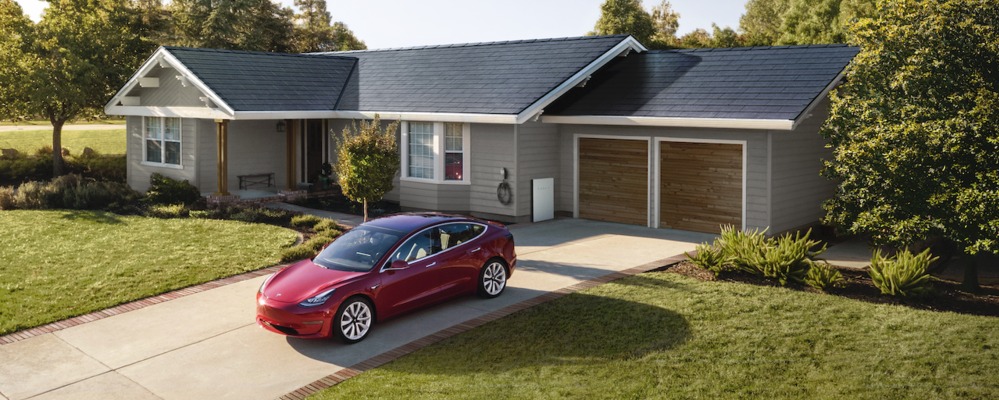
Find out how much solar costs to install on your roof
Key takeaways
-
Average total price: $106,000
-
Tesla Solar Roof price per square foot of roof space: $62 per square foot
-
Tesla Solar Roof cost per watt of solar: $16.00 per watt
-
What we like: Looks great, durable, all-in-one warranty
-
What we don’t like: Price, long-term savings, limited availability
-
Who the Solar Roof is for: Technology and Tesla enthusiasts, or people building new luxury homes.
-
Who the Solar Roof is not for: Homeowners that prioritize return on investment and value for money
A typical Tesla Solar Roof costs upwards of $100,000, depending on the size and complexity of your roof and how much solar power you need.
If that price looks expensive, it’s because it is. The high price tag is partly because getting a Tesla solar roof requires a complete roof replacement, not just installing solar. Even so, a traditional roof replacement and solar installation is over $66,000 cheaper than a Tesla roof, on average.
Because of the Solar Roof’s high price and design, a Tesla roof isn’t worth it for most homeowners who want to go solar. Even Tesla CEO Elon Musk said Tesla’s solar shingles are “a premium product” in the company’s 2024 Q4 earnings call. Let’s take a look at what the Tesla solar roof has to offer, how much Tesla solar shingles cost, and how to know if it’s worth it for you.
How much does the Tesla solar roof cost in 2025?
An average-sized Tesla Solar Roof will cost a total of $106,000 before incentives are applied; this works out to about $15 per watt of solar installed or $63 per square foot of roof space. Both estimates include the costs of installing the solar and non-solar tiles.
Remember, the Tesla Solar Roof acts as a solar installation and a roof replacement, so these costs include installing a new roof and tearing off the existing roof. For our example, we didn’t include the cost of the Powerwall home battery, but homeowners often pair them with Tesla’s Solar Roof product.
The total cost of a Tesla Solar Roof installation will vary considerably depending on the company that installs it, the size and complexity of your roof, and how much energy your home uses.
The following table outlines cost estimates of different-sized Tesla Solar Roof systems:
Tesla Solar Roof size | Tesla Solar Roof cost |
|---|---|
4 kW | $64,000 |
6 kW | $96,000 |
8 kW | $128,000 |
10 kW | $160,000 |
12 kW | $192,000 |
14 kW | $224,000 |
Tesla solar roof costs over time (2020 - today)
Based on estimates provided on Tesla’s website in 2020, the total cost of a Tesla Solar Roof has increased by about 170% over the past five years, with significant increases at the end of 2023.
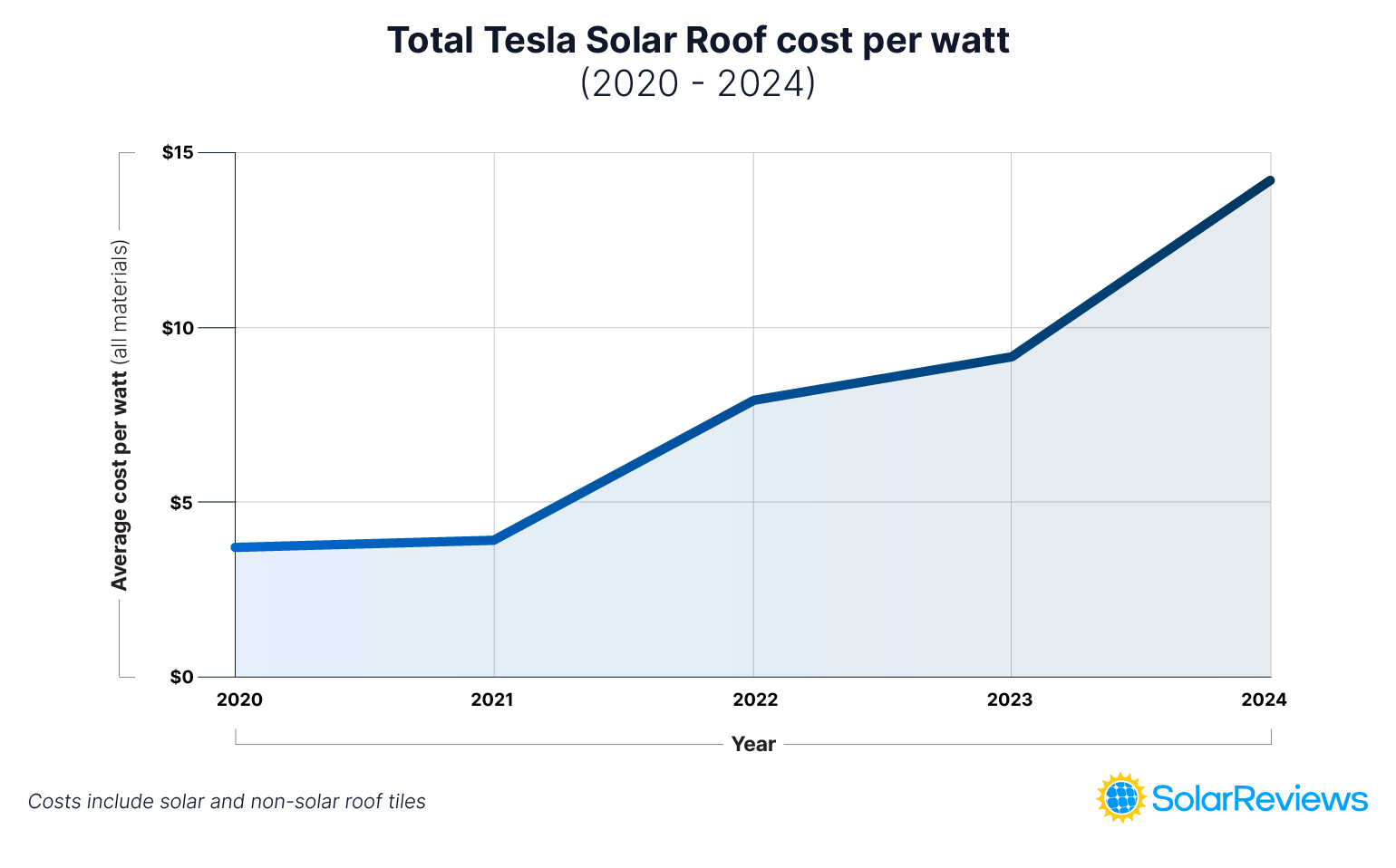
Some of the price increases could be attributed to Tesla’s pivot away from direct installations and relying on third-party installers. Still, it seems Tesla may have underestimated the material and labor costs for its roof shingles.
3-step Tesla Solar Roof cost calculator to estimate your solar roof price
Figuring out the price of a Tesla Solar Roof can be tricky because it’s a complex system that is tailored specifically to your energy needs and your roof. But, if you know how much solar you need or the size of your roof, you can get a ballpark estimate of the price of a Tesla Solar Roof.
Just remember that the actual cost of installing a Tesla Solar Roof will depend on the size and complexity of your roof, the amount of solar you need, and the installer that you choose!
What is the Tesla solar roof system?
The Tesla Solar Roof is a total roof replacement that covers your roof in a combination of solar shingles and non-solar roof tiles. Solar shingles are designed to generate electricity but look more like traditional roofing materials than solar panels.
Any part of your roof without solar tiles will be covered in non-active metal shingles. The solar and non-solar shingles look almost identical, so you can’t tell what part of your roof is producing power and what part isn’t.
The Tesla Solar Roof is composed of a few different pieces of equipment, each contributing to the total cost of the Solar Roof installation. There are four key components of the Tesla Solar Roof, each with a different price and function:
Active solar shingles that generate power from sunlight.
Inactive shingles that protect your roof and help the solar shingles blend in.
A Tesla Powerwall 3 battery that stores excess solar power for you to use later or provides backup during a power outage. Tesla Powerwall batteries are some of the best home energy storage systems on the market.
A Tesla solar inverter to convert the electricity generated by your solar roof into energy that can be used by your home and stored in your battery.
Tesla solar shingle specs
Tesla Solar Roof | Rating |
|---|---|
Power output per tile | 72 W |
Size | 15” x 45” |
Wind rating | Class F |
Fire rating | Class A |
Hail rating | Class 4 |
Tesla solar shingles have a power output of 72 watts each and measure 15 inches by 45 inches in size. These are much smaller than traditional solar panels, which helps boost their aesthetic. However, Tesla’s solar tiles are less efficient when compared to solar panels, delivering about half as much power per square foot. It’s important to note that the edges of the solar-powered tiles do not contain photovoltaic cells, so the actual efficiency is likely a bit higher.
The Tesla Roof has the highest ratings possible for wind, fire, and hail, making it durable and capable of protecting your roof.
Tesla Solar Roof warranty
The Tesla Solar Roof comes with both traditional solar warranties and roofing material warranties. In total, you’ll have three 25-year warranties for your Tesla solar shingles:
25-year product warranty that ensures your shingles will be free from manufacturing defects
25-year power output warranty that your system will operate at 95% of its rated peak power after five years and will lose no more than 0.5% during each of the remaining 20 years of the warranty period.
25-year weatherization warranty that guarantees your Solar Roof will prevent wind and rain from passing through to your home.
Pros and cons of Tesla solar shingles
There are many advantages and disadvantages for the Tesla Solar Roof, including:
Pros
-
Sleek design with unnoticeable solar
-
Tesla’s popular energy management system
-
One warranty for all components
Cons
-
Extremely expensive
-
Lower lifetime solar savings than solar panels
-
Limited availability + potential wait times
-
Limited real-world applications
6 factors that impact Tesla Solar Roof costs
Much like with regular home solar panels, the cost of installing a Tesla Solar Roof system will depend on various factors unique to your home and energy needs. Here are some things that have the most significant impact on the cost of installing Tesla solar shingles:
Tesla Solar Roof vs. traditional solar panels
A Tesla Solar Roof installation costs about $16 per watt of solar installed, whereas traditional solar panels cost about $3.03 per watt. Let’s examine some differences between the Tesla Solar Roof and a conventional solar installation.
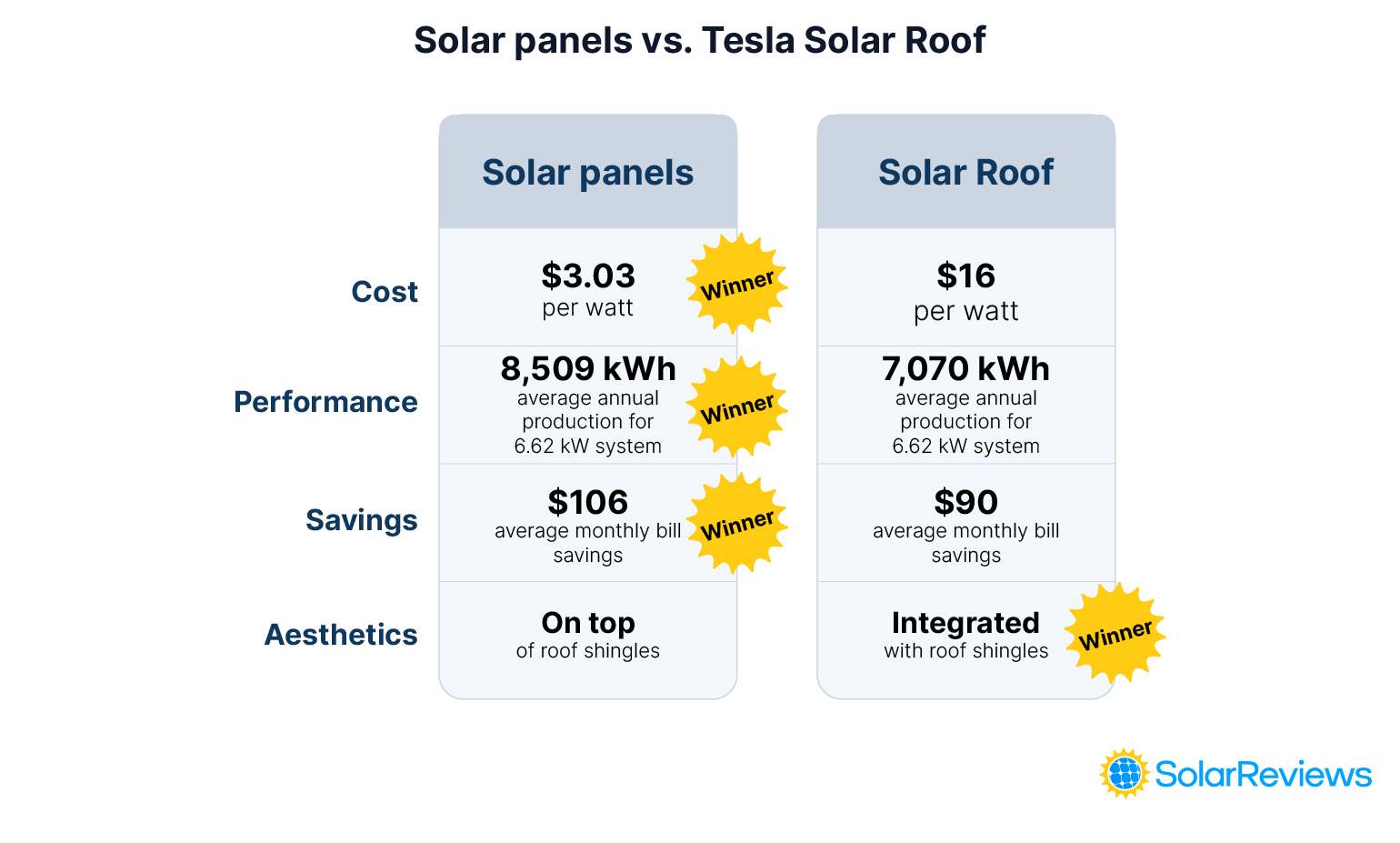
Estimates based on a 6.62 kW system
Cost
Winner: Solar panels
A Tesla Solar Roof is almost five times more expensive than a standard solar panel installation, but the cost of Tesla’s roof does include a full roof replacement. So, to really compare the price, we need to see how much a Tesla Solar Roof costs to how much it costs to install solar panels and get a roof replacement. The following graph outlines the difference:
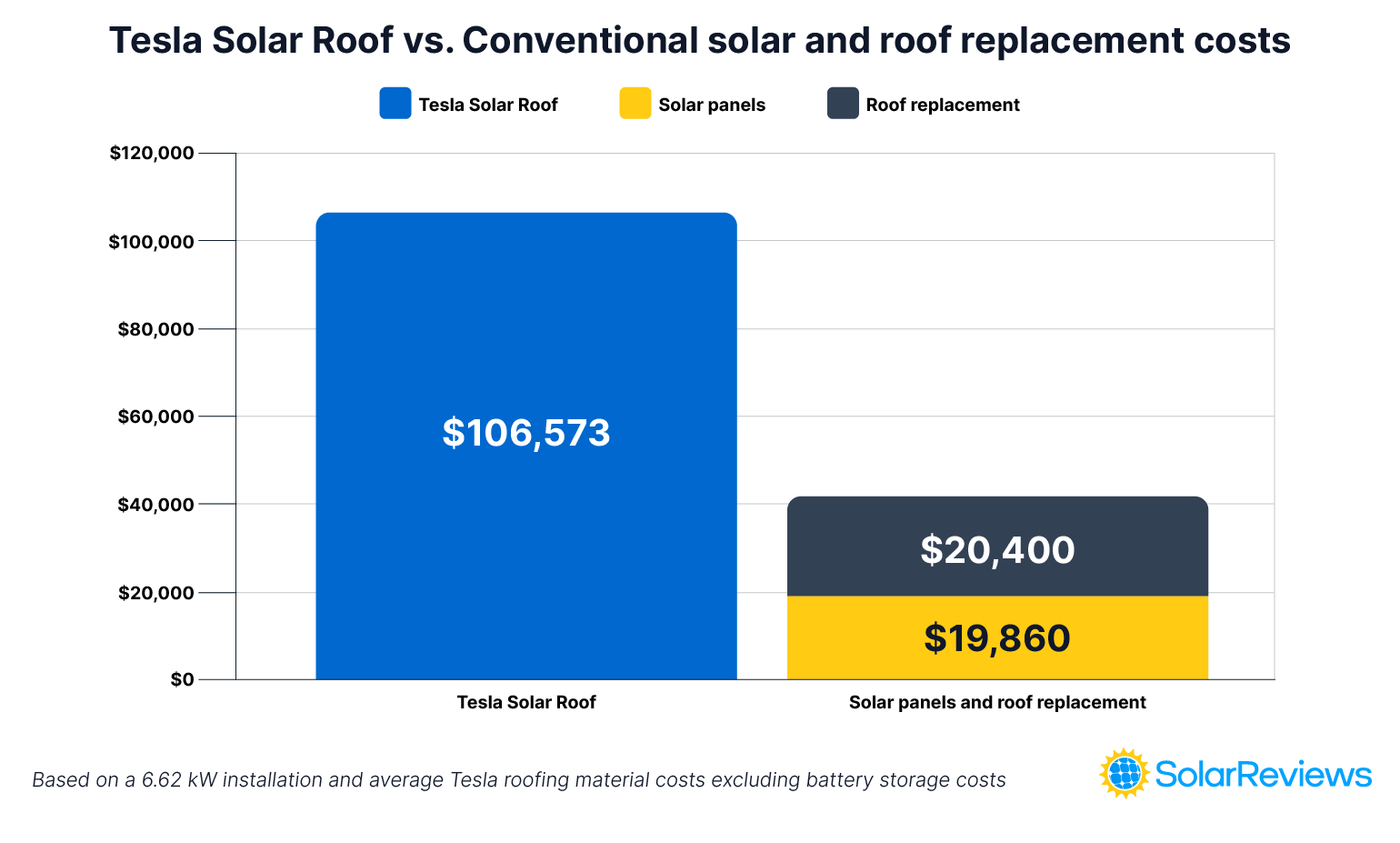
An average-sized Tesla Solar Roof will cost about $106,000, while traditional solar panels and a roof replacement will cost just over $40,000.
Even when you consider the average cost of a roof replacement and a typical solar installation, the cost of a Tesla Solar Roof is still 90% higher. We even compared the reroofing price of premium copper roofing to try and match Tesla’s luxury steel shingles, and the Solar Roof still came out nearly $7,000 higher.
Performance
Winner: Solar panels
Solar shingles usually produce less energy than solar panels because they have to lay flat against the roof, meaning the shingles have to be installed at the same angle as your roof, which might not be ideal for generating electricity.
Traditional solar panels, on the other hand, are mounted on racking systems so the panels can be positioned for maximum solar energy production. This also allows airflow beneath the panels to keep them cool and operating as efficiently as possible.
The following table outlines the energy production for difference-sized Tesla solar roof systems vs. production estimates of solar panels:
System size | Est. annual Solar Roof energy production | Est. annual solar panel production |
|---|---|---|
4.54 kW | 4,850 kWh | 5,836 kWh |
6.62 kW | 7,070 kWh | 8,509 kWh |
7.78 kW | 8,310 kWh | 10,000 kWh |
8.64 kW | 9,228 kWh | 11,106 kWh |
9.79 kW | 10,456 kWh | 12,584 kWh |
11.88 kW | 12,688 kWh | 15,270 kWh |
Each Tesla Solar Roof tile produces 72 watts and is about one-quarter the size of a traditional solar panel.
Expert insight! While the cost of solar equipment is cheap, the cost of Tesla’s non-solar roofing materials is not. Joe Roberts, a home improvement expert from Fixr, clues us in on how Tesla’s roofing costs compare to typical roof replacement costs: “Tesla’s price point is much higher than what most homeowners would pay to replace their roof. The most premium metal roofing options cost about $47 per square foot on the high-end.”
Savings
Winner: Solar panels
An average-sized solar roof will provide about $90 in monthly electricity bill savings, or roughly $35,600 over the system's lifespan. However, actual Solar Roof savings will depend on where you live, how much energy the Solar Roof produces, utility net metering policies, and local electric rates. The same-sized solar panel system would give $106 in monthly solar savings.
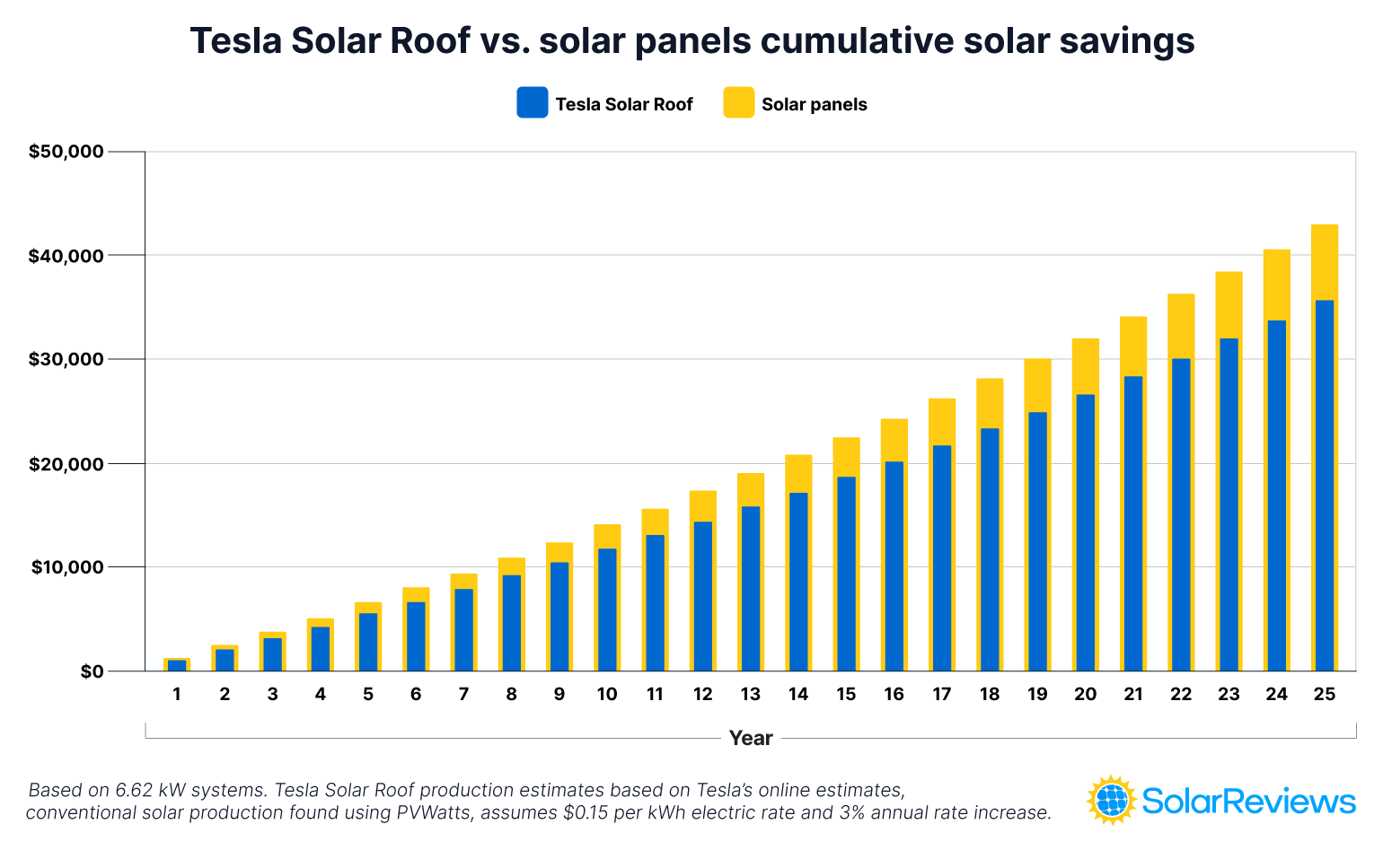
The high upfront costs of the Tesla Solar Roof make it unlikely that you will ever see a return on your investment. Based on Tesla’s pricing and production estimates, by the end of the Solar Roof’s 25-year lifetime, the system will have only generated enough electric bill savings to cover about one-third of its total cost.
Solar panels generate enough electricity to pay for themselves after about 12 years, providing another decade of free energy.
Aesthetics
Winner: Solar Roof
The one category where the Tesla Solar Roof has solar panels beat is looks. The Tesla Solar Roof is designed to look like a roof, and the difference between solar and non-solar shingles is nearly indistinguishable. This means you can enjoy the benefits of solar without sacrificing your home’s curb appeal.
Conventional solar panels are a bit more noticeable on your roof because they aren’t completely integrated with your shingles.
Tesla Solar Roof maintenance and upkeep costs
The Tesla Solar Roof requires very little maintenance. Tesla’s shingles are slick, and regular rainfall is usually enough to keep the roof dust and debris-free. But if your roof is prone to build-up or you live in a dry area that doesn’t get much rain, you may need to spray down the shingles to keep them operating at their very best.
Tesla recommends hiring a professional to clean a Solar Roof to minimize any risk of damage to the product and harm to yourself. However, if you choose the DIY solar cleaning route, you should not apply any cleaning solutions to the solar roof. Simply use a garden hose and spray in the direction water would normally flow down your roof, meaning you should not stand on the ground and spray up on the Solar Roof.
Is the Tesla Solar Roof worth it?
The Tesla Solar Roof is not a worthwhile financial investment. The savings generated by the Solar Roof won’t recover the installation cost, and in almost every scenario, installing solar panels and getting a conventional roof replacement is cheaper.
If we were to recommend the Tesla Roof to anyone, it would be people looking for a luxury upgrade to their home who really like the Tesla brand. It may also be one of the few ways to go solar with an HOA, making installing solar panels difficult. The Tesla Solar Roof looks great and matches the vibe of modern homes. Those in the luxury real estate market might also like the idea of purchasing a house with a high-tech roof.
However, it’s important to note that Tesla’s energy division has a poor reputation when it comes to customer service. Tesla has 2.6 out of 5 stars on SolarReviews, so it seems clear customers aren’t satisfied with after-installation care. Many call Tesla “unresponsive” and report substantial wait times for repairs. These issues might not be as prevalent if you install a Solar Roof through a local installer, but that local service likely comes with a higher price tag.
Overall, except for aesthetics, regular solar panels outshine the Tesla Solar Roof. Installing solar panels is significantly cheaper, generates more electricity, and is widely available. At the very least, you should consider getting solar panel quotes and Solar Roof quotes from qualified installers in your area to get the best deal possible and find the right installation for your home.
Tesla solar roof frequently asked questions (FAQ)
Catherine has been researching and reporting on the solar industry for five years and is the Written Content Manager at SolarReviews. She leads a dynamic team in producing informative and engaging content on residential solar to help homeowners make informed decisions about investing in solar panels. Catherine’s expertise has garnered attention from leading industry publications, with her work being featured in Solar Today Magazine and Solar ...
Learn more about Catherine Lane